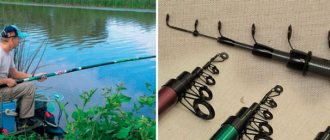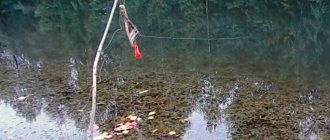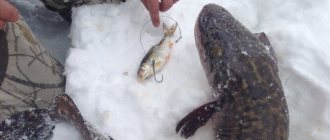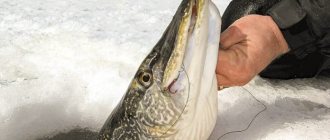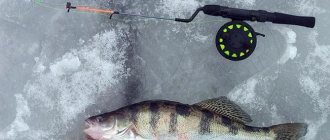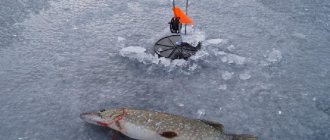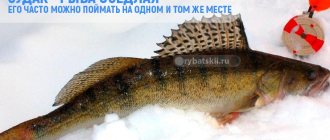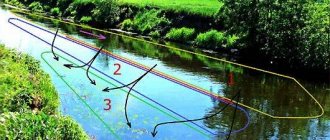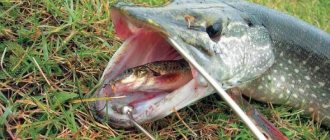Content
- 1 Features of the girders
- 2 Types of girders 2.1 Girders for fishing in open water 2.1.1 Flyer girder
- 2.1.2 Tubular vents
- 2.2.1 Girders on the platform
- 4.1 Zywiec
Winter fishing with flags and supplies
Gear fishing in winter, despite the apparent simplicity of the gear, is full of small features and nuances that ultimately determine the quantity and quality of the catch. We discussed the secrets of the correct tactics and technique of zher fishing in winter in the article: https://berlogakarelia.ru/lovlya_zimoj/zherlicy/zimnyaya-rybalka-na-zherlicy
Attention should be paid to the design of the flags themselves, striving for maximum simplicity and reliability. Girder equipment for winter fishing is selected based on the following factors:
- Type of predatory fish, its estimated size.
- The size of the fish or other bait, the method of attaching the live bait to the hook.
- The nature of the tactics is active fishing with flags or setting up supplies at night.
- Conditions of the reservoir - depth, snags and vegetation, absence or presence of current and its strength.
- Winter period - in the dead of winter, a passive predator needs thinner equipment.
Features of the girders
Classic girder
This simple tackle is designed for catching predatory fish exclusively with live bait. It may have several design options, but the essence comes down to one thing: the predator is presented with a bait mounted on a hook connected by a fishing line to a fixed base, which, as a rule, is located above the water. Typically, fishermen use several poles. Their number can be any, as long as the area of the reservoir and the capabilities of the fisherman allow.
Despite the fact that today you can buy any tackle in the store, fishermen prefer to make girders with their own hands. This is absolutely not expensive and takes very little time. A good fisherman can have a dozen and a half girders in his arsenal. If you know where to look for a predator, this amount is enough to get a pretty good catch. Making girders with your own hands is gradually developing into a kind of hobby for some fishermen. Making these tackles themselves, craftsmen constantly modernize them, bringing them to perfection.
Varieties of girders
- Flat base. The disk vent floats on water or is installed on ice;
- Kaganok. Vertical vent with reel;
- Vertical stand. The zherlitsa is stuck into snow or ice.
Summer zherlitsa
- Postavukhi. Live bait is hooked and thrown into the water. The second end of the tackle is secured on the shore (by a peg or hook). The trick: to prevent the fish from leaving, you need to make 1.5 - 2 meters of free line;
- Hanging. A wooden slingshot with a cord is suspended from a tree or stick above the water. The live bait is lowered into the water along with the sinker. When biting, the slingshot will begin to relax the line;
- With a reel. A peg with a rope is driven into the shore, the tackle with live bait is thrown into the water. When biting, the coil will begin to unwind, releasing the signaling flag;
- Floating. A round flat float is made, onto which a flag is attached, on the opposite side of the fishing line with live bait. A fishing line is attached to the edge of the float, which will be controlled by the fisherman from the shore. In order for the fish to move better to the girder, fishermen recommend securing grass along the edges of the circle.
Winter zherlitsa
- Postavukhi. The structure can stand all winter. Its main principle: the bait with live bait is located in a hole under water. To check or get the catch, you need to drill another hole nearby and pick up the girder with a hook. Trophies are pulled out through a new hole;
- Plates. Budget option for winter fishing. The basic principle: the “plates” completely cover the hole and then signal the catch. The main disadvantage of this design is that fish are caught from under the “plates”;
- Homemade. A wire spool is attached to a wooden rod. When it freezes, the structure can be covered with snow, which will prevent the hole from freezing.
- Rack. The pointed end of the girder is stuck into the snow, and a signaling flag is installed on the opposite side. In the middle of the structure is a reel with a fastening mechanism;
- Tripod. The principle is the same: the reel and line are between the legs, and the flag is on the top;
- Load-bearing base. Homemade wooden plates on which legs and a flag are installed. The legs can be made to any position, it all depends on the preferences of the fisherman. The main advantage of such girders is the complete closure of the holes.
A baitfish wounded by a hook, even with the most careful hooking through the “back” or by the tail, has little desire to behave actively in a reservoir and relatively soon becomes dead. Accordingly, from the point of view of the same pike, it no longer looks so “appetizing” that a lightning-fast bite would follow.
Alarmist
Blocked
K.A.P.1972
jeny256
Silala
A baitfish wounded by a hook, even with the most careful hooking through the “back” or by the tail, has little desire to behave actively in a reservoir and relatively soon becomes dead. Accordingly, from the point of view of the same pike, it no longer looks so “appetizing” that a lightning-fast bite would follow.
At the same time, if there is no result for a long time, the novice fisherman repeatedly checks the abandoned tackle or replaces live bait, which alarms the fish, for which any suspicious object is dangerous due to its innate instinct. Experienced fishermen who prefer to catch predators using casting rods with bait in the form of live bait have long learned to overcome such obstacles in a fairly simple way.
How to attach live bait - a tricky way
How to attach live bait with maximum fishing effect When baiting live bait, no matter on a double or tee, cunning advanced fishermen use a method of fixing it on the hook in the form of a kind of bridle.
Tips for a fisherman: How to attach a diverter leash to a winter fishing rod - Let’s take it step by step
Simply put, the hook is, as it were, attached to the body of the baitfish without a puncture. An elastic band for money or a piece of so-called aircraft model rubber (See picture) is ideal as a fastener.
What are the advantages?
With its help, the live bait is fixed on the hook and does not lose its viability until the very moment of the bite. Actively trying to get rid of the rubber band, he is forced to make movements in the water that imitate a sick or wounded fish. Of course, this behavior of the bait is very attractive to any predator.
In addition, predatory fish detects its prey not only with the help of its visual organs, but also by detecting even slight fluctuations in the water caused by the attempts of the baitfish to free itself from its bonds. Thus, a fry “restrained” with an elastic band is able to attract the attention of those fish that are located far enough from the place where the casting rod is cast.
At the same time, the fisherman is confident that the bait has not died, and therefore there is no need to once again remove the tackle from the water, thereby alerting freshwater “hunters” for small fish.
It turns out that this little trick successfully copes with two factors at once that influence the “lack of biting” of predators - violation of silence and constantly active live bait. This method of attaching live bait is also excellent when hunting for such freshwater “monsters” as snakeheads, catfish or burbot. You just need to slightly lengthen the leash with live bait so that it can actively move around the bottom, but not move far from its surface.”
Despite the fact that each angler chooses his own method of attaching live bait, some patterns have gradually emerged. This way, fastening to the back is used when fishing for perch and pike perch. If they catch burbot, they use a single hook, and the method of attachment does not matter. Pike hunting is another matter - here the best option would be a leash passed under the gills.
Types of girders
Despite the huge number of girders found on sale, they can be divided into 2 types: for open water fishing and for winter fishing
Jigs for open water fishing
Zherlitsa-flyer
Flyer fliers appeared a very long time ago. However, despite the somewhat primitive design, it is still found in reservoirs today. In addition to pike, the catch will include such species of predators as perch, pike perch and catfish. To make a flyer you will need a minimum amount of materials and fishing equipment.
- First of all, you will have to go in search of bushes or willows. Using a sharp knife, forks are cut out that resemble children's slingshots. Even better is to find dry wood. Then you won’t have to waste time drying the material.
- A narrow cut is made on one of the cuttings of the workpiece, and then a shallow split. The line of the equipped girder will be fixed in the cut.
- To equip the flyer, you need brown or green monofilament fishing line with a diameter of 0.5-0.6 mm. The choice of line shade is determined by the color of the water in the summer water area. The thickness of the monofilament is determined by the frequent need to pull the tackle out of the grass thickets, where the predator usually rushes after a bite. The main fishing line should be wrapped around the flyer in a figure eight shape. By the way, if you wind the monofilament or cord too tightly, they will become deformed.
- To limit the mobility of live bait, it is necessary to equip the bait with a sliding sinker in the shape of an olive. The weight of the load is selected according to the size of the live bait, the fishing depth, and the strength of the current.
- A swivel with a carabiner is attached to the end of the monofilament. This scheme for attaching a metal leash allows you to quickly dismantle it along with a predator that has deeply swallowed the bait.
- A metal leash is a mandatory element of a fishing rod when fishing for pike. If the main predator in a given water area is perch or pike perch, then you can do without a wire structure.
- The choice of hook is determined not only by the size of the intended trophy, but also by the size of the bait. Typically, bait fishermen use doubles or trebles for catching pike and pike perch, as well as single models when hunting perch. It is better to attach live bait by the dorsal fin, since it lives longer with this installation.
- A through hole is made on the handle of the flyer for attaching a strong rope. Its task is to connect the girder with a coastal bush or with a specially driven stick.
Tubular vents
The emergence of modern materials for construction needs has not gone unnoticed by savvy fishermen. As a result, a new variety of summer zherlitsa appeared.
- To create a fishing masterpiece, you will need a polymer pipe for water supply or sewerage. The optimal diameter of the material is 50 mm. The length of the segment can vary between 60-70 mm. In addition to the plastic pipe, you need to find a piece of a bicycle tube.
- Two through holes are made in the upper part of the tube, one of them is required for installing the rope. She will be responsible for fastening the girder with a stationary object on the shore of the reservoir. The second hole is intended for tying the main fishing line.
- A piece of monofilament 15-20 m long and 0.5 mm thick is wound onto the pipe. The vent is equipped with a sliding weight weighing 10-15 g. It is locked with a rubber damper, and a swivel with a fastener is tied to the end of the monofilament thread.
- To fix the vent in the transport or working position, a section of a bicycle tube 1-2 cm wide is pulled onto the pipe.
- A plastic box of the appropriate size is suitable for storing and transporting tens of such gear.
Ice fishing rods
Priests on the platform
Girders for winter fishing Girders on a platform are installed on the ice using wooden or plastic platforms, and have an advantage over pole-mounted girders in that they shade the hole, which is especially important when fishing in shallow water.
In addition, the hole, covered with a platform, is at least slightly protected from freezing, which is also important, since the fishing line does not freeze into the ice, and the predator does not throw the bait, having felt significant resistance, the fishing line not being able to unwind. The disadvantage of such girders is that the quality of their manufacture, as a rule, leaves much to be desired, especially the assembly of the reel to the platform suffers. If, after purchasing, you do not check and modify them yourself, then there is a high probability that it will fail at the most inopportune moment. The next disadvantage of such girders is that if they are left in one place for a long time, then on a sunny day, the ice around the base, as a rule, thaws, and in the evening it freezes again, tightly freezing the girder to the hole. Removing it can be problematic, and attempts to rip it out by force sometimes lead to breakage.
In addition, its main advantage - shading the hole and protecting it from freezing, easily disappears at temperatures that drop to minus ten degrees. The fishing line still freezes, and there is practically no use from the fishing platform. Yes, at the vents on the stand, the fishing line also freezes into the ice, but in frosts of ten degrees, they do this: first they wait until the hole is covered with a thin ice crust, which happens in almost a minute, then the fishing line is slightly tugged so that a kind of “channel” is formed. in the ice, and with further freezing, the line did not stop. Then, a thin ice crust is sprinkled with snow, which darkens the hole, so a girder on a platform has no advantages over a girder on a stand, except that it is easier to install - for girders with a stand, you have to carry a special gimlet with you to drill holes for the stand.
Zherlitsa on the counter
The racks on the stand are much more compact than the racks on the platform, due to the absence of bulky platforms. In addition, the spool, as a rule, is quite rigidly fixed to the stand, and the stand itself is made of durable metal or wood, which eliminates the possibility of breakage. The next advantage of racks with a stand is their height. The signal flag is located at the very top end of the stand, and when triggered, is clearly visible, unlike the flags of platform vents, which are sometimes even completely covered with snow. The disadvantages of such girders are the same as those of platform girders. This, in addition to the fishing line freezing into the ice, also freezes the reel to the bobbin. The reel, frozen to the mount, does not rotate when a predator bites and does not release the line as expected, and therefore the predator often throws a suspiciously strong fish, wondering if something is wrong.
Zherlitsa "Taganok"
“Taganok” is a structure in the form of an aluminum tripod with a reel and a flag located on it. This zherlitsa is not often made by hand, as it requires certain metal processing skills and the availability of the necessary tools.
Advantages:
- compactness and ability to fold the structure;
- ease of transportation.
Flaws:
- a do-it-yourself vent can only be made if you have metalworking skills and the appropriate tools;
- poor stability in strong wind conditions.
Varieties of winter girders
Catching predators in winter from the surface of the ice of a reservoir is carried out with the following common modifications of girders:
- Platform (checkboxes).
- Vertical (racks).
- Tripods (Taganka).
- Horizontal.
- Changelings.
- Sub-ice.
- Specific.
Let us consider in detail their design, operating features and principle of operation.
Set of vents on a stand ZhZ-03 Tonar 1,245 for 1 piece. Set of vents on a stand ZhZ-04 Tonar 1,180 for 1 piece. Zherlitsa on a stand ZhZ-03 Tonar 94 for 1 piece. A set of vents on a stand equipped with ZhZO-02M (d-185mm, d-85mm coil) (10 pcs) Tonar 1,935 for 1 pc. Set of vents on a stand ZhZ-05 Tonar 1,190 for 1 piece. Zherlitsa on a stand ZhZ-02M Tonar 90 for 1 piece. A set of vents on a stand equipped with ZhZO-04 (d-185mm, d-63mm coil) (10 pcs) Tonar 1,890 for 1 pc. Zherlitsa with a straight stand BLUE with a white, gray coil Three whales 48.30 for 1 piece. A set of vents on a stand equipped with ZhZO-05 (d-210mm. coil d-63mm) (10 pcs) Tonar 1,930 for 1 pc. Zherlitsa on a stand ZhZ-04 Tonar 86 for 1 piece. A set of vents on a stand equipped with ZhZO-03 (d-210mm. coil d-85mm) (10 pcs) Tonar 1,975 for 1 pc. Zherlitsa on a stand equipped with ZhZO-04 (d-185mm. coil d-63mm) Tonar 165 for 1 pc. Zherlitsa on a stand equipped with ZhZO-05 (d-210mm. coil d-63mm) Tonar 170 for 1 pc. A set of girders with a corner post in a bag with colored spools d.85-90 Three whales 102.70 for 1 piece. Zherlitsa on a stand ZhZ-05 Tonar 90 for 1 piece. Zherlitsa on a stand equipped with ZhZO-02M (d-185mm. coil d-85mm) Tonar 170 for 1 pc. A set of girders with a corner post in a bag with a black reel d.60-65 Three whales 96.60 for 1 piece. Zherlitsa on a stand equipped with ZhZO-03 (d-210mm. coil d-85mm) Tonar 175 for 1 pc. A set of girders with a corner post in a bag with a black reel d.85-90 Three whales 96.60 for 1 piece. Zherlitsa with a straight stand BLACK in a BAG with color. reel Three whales 96.60 for 1 piece. Zherlitsa with a corner post with a yellow coil d.60-65 Three whales 60.40 for 1 piece. Three-legged ALUMINUM vent with coil 85-90 mm Three whales 128 for 1 piece. Zherlitsa with a straight stand BLACK with a yellow coil Three whales 60.40 for 1 piece. Reel for 60-65 mm spool Three whales 15 for 1 piece. Zherlitsa with a straight stand BLACK in a BAG with a white, gray coil Three whales 84.60 for 1 piece. Reel for 85-90 mm spool Three whales 21 for 1 piece.
Platform
The platform platform differs from other modifications in the presence of a base. This is a piece of plastic, plywood or board about a quarter of a meter across, on which a reel on a stand and a flag are placed. The platform can be round, square, rectangular
.
A special slot is made in its surface for passing the fishing line. The main advantages
of this gear option:
- Darkening the hole from natural illumination, which protects the fish from being frightened by daylight.
- Preventing the hole from freezing, which facilitates the free passage of fishing line with gear and catch.
However, there are also specific disadvantages
:
- Large dimensions.
- Poor quality fixation of structural elements.
- Freezing of the base to the ice (breakage during removal cannot be avoided).
- The reel is small in size or does not rotate well.
- The need to install signal posts during snowfall due to the low height of the vents.
- Freezing of fishing line at temperatures of -100C and below.
In addition, many purchased models require modification, which will be discussed below. Next, we will consider the most popular versions of vents with a base
and their features.
- Kurskaya
. High-quality tackle with a plastic stand and base for snow. Equipped with a large reel. The design provides for the use of anti-beard. - Terminator
. Developed on the basis of the above described option. It features a platform made of impact-resistant material, a birch block as a stand, a reinforced bolt-on reel, the presence of an anti-beard loop, and the ability to increase the height of the stand in case of snowfall. - Corner stand
. It is characterized by an angled reel mount, simplicity and reliability in operation, but a minimum height, which is inconvenient in conditions of heavy winter precipitation. - Height
. It is distinguished by a metal stand for the reel. The downside is the small height. - Akara/Aelita
. Features: a reel for unimpeded line release when biting, a bright plastic flag. Different models use racks of different heights.
Refinement of platform girders
Refinement of purchased versions of platform girders comes down to the following points:
- Disassemble the coil and remove irregularities and roughness from the inside of the hole for the mounting axis using sandpaper or a file.
- Achieve the optimal level of tightening by adding washers and replacing the nuts with wing clamps.
- Bring the torsion of the reel when pulling the fishing line to optimal smoothness and uniformity, with a braking effect. To solve this problem, you will need to place a ferrule pad under the tightening bolt.
- Coat wooden elements with varnish to prevent saturation of the material with moisture.
- Apply stripes of bright paint to the reel disk to make it easier to track the speed of unwinding of the fishing line.
- Use a sharp blade to remove burrs from the hole for the line to pass through in the base.
- Glue the platform from below with thermal insulating material.
- To make it easier to fix the hooks during transportation, stick a piece of foam rubber onto the rack.
- To prevent the material of the flags from falling off after a couple of operations, it should be additionally stitched and glued.
Vertical
The design of the vertical girder is a stand
with a coil attached to one of the edges.
Among its main advantages
are:
- Sufficient height to detect a signal in any snowfall.
- Convenient transportation.
- The universal mount allows you to attach the reel to stands made of any material - wood, plastic, metal.
- Can be used in open water.
Flaws
:
- Low stability - to eliminate it, the stake must be driven very deep, or an installation hole of a suitable diameter must first be made for it in the ice.
- In severe frosts, the hole freezes along with the fishing line, and the reel may also freeze.
Tripods
The tripod reel is ideal for setting up on bare ice when there is no or very little snow. However, in real conditions, such a model has many disadvantages:
- Complex design.
- Large dimensions make transportation difficult.
- Stability is weaker than that of platform variations.
In addition, the hole does not have frost protection, and icing of the reel and freezing of the fishing line are added to the list of disadvantages. Therefore, this type of gear is used very rarely.
Horizontal
They exist in two versions - homemade and factory-made. In the first case, they have the simplest design, not without flaws - a reel made of a piece of plywood or board and a flag attached to it by means of a spring. The device is considered unreliable due to the following features:
- Part of the fishing line is simply laid on the ice, as a result of which it can easily freeze or get tangled.
- Unreliable fixation of the flag often leads to its accidental signaling.
- In severe frost, the ice hole is not protected from icing.
The second option is better known as the American zherlitsa
. For stable operation, it is equipped with a spool for fishing line, placed under water. The devices have proven themselves well. The only drawback is the high cost.
Changelings
The tackle is an inverted stand. A reel with a fishing line lowered into the hole is tied to one edge, the other with a bright signal lies on the ice. As soon as a bite occurs, the structure turns over and the flag rises. The advantage of such systems is their simplicity and the possibility of rapid production from scrap materials. The disadvantages are the same as those of models without reels - freezing of the line, icing of the hole, etc.
Subglacial
Under-ice traps differ from all the versions discussed above in that they do not have an alarm. To check whether the predator has caught the bait, you will need to remove the device from the hole. Such self-catchers are used as supplies for commercial fishing. The fishing line is wound with a reserve on a reel made from a tube, bottle or spear. It, in turn, is attached by means of a cord to the crossbar outside the hole.
At the same time, to check, re-equip and extract the catch, another one is drilled nearby, since the first one is completely frozen. The equipment is no different from analogues with flags. Sub-ice vents must be marked on the outside, for example, with a twig stuck in the snow, so that in the event of a snowstorm they will not be lost during inspection. Self-catchers of this type are designed for passive fishing - they are installed in the evening and checked only in the morning.
The main advantage of this fishing method is that it remains fully operational in all weather conditions. The fishing line will not freeze in the water and will remain mobile even in the most severe frosts.
Specific
There are a number of other, specific girders - made both with your own hands and at the factory. An example is the “ Cool”
" It has a base made of floating material. Therefore, in winter it can be installed on a hole, in summer - on water. The design contains a coil and a flag with a spring mechanism.
In some cases, in order not to miss a bite signal, winter girders are equipped with bells or lights. This is especially true in conditions of poor visibility - fog, twilight, at night. However, in this case, the design of the gear becomes more complicated due to the introduction of electrical elements and requires special measures to maintain their functionality. The circuit, power supply, wiring and lamps must be reliably protected from freezing and humidity.
Gear equipment
Gear equipment Any girder must be equipped with equipment.
The main thing is the fishing line. There is no point in using expensive fishing line options for girders; it is enough to purchase an average-priced one. The diameter of the fishing line ranges from 0.2 to 0.35 mm. It all depends on the size of the expected fish caught. It is necessary to wind the fishing line with a reserve on the reel or reel. I lay about 20-25 meters. The reserve is needed so that the pike has time to swallow the bait while moving. Instead of a steel leash, I use fluorocarbon, it is very convenient to use. In addition, you can make the required length yourself. Fluorocarbon is strong enough for pike to bite through. I choose a fluorocarbon cross-section from 0.25 to 0.35 millimeters (depending on the expected fish caught). The sinker needs to be selected depending on the live bait. If the live bait is small (20-50 grams), then a weight of 10-15 grams is enough. If we use larger live bait when fishing, then we will need a heavier load. This is due to the fact that the live bait is mainly trying to float up under the ice, and is not at the depth we need.
The hook must match the intended bait. So, for example, I never use a single hook on pike; it’s mostly a double or treble hook. For winter fishing, smaller hooks can be used than when catching a predator in the fall. This is due to the fact that fish are less active in winter. The water in the reservoir settles and becomes very clear, and this unmasks the hook.
How to properly place a jig on a pike
When “quiet hunting” for pike in winter, it is important not only to choose a high-quality and functional girder, but also to install it correctly.
First of all, it is necessary to find the place of greatest localization of the predator:
- According to the first ice, the main zone of distribution of fish is considered to be shallow water;
- during the deep winter period, the pike goes to the very depths of the reservoir.
Depending on the preferences of the fisherman, pike can be caught in winter using above-ice or under-ice girders. Along the first ice, the gear is installed in shallow water, placing them from shallow to deep or in a checkerboard pattern. If some of the girders are “silent” for 1–2 hours, they are moved closer to the active ones.
Video: Rigging a rig for pike
In the middle of winter, the best gear options are considered to be under-ice devices or flags with signaling devices. Under-ice ones are mounted at night only in relatively warm weather, otherwise they can freeze very much. It is also very important to correctly determine the depth of casting live bait. Many people believe that the bait should be closer to the bottom, but this is not always the case. This indicator may depend on the depth of the reservoir, oxygen concentration in different layers of water, climatic conditions, etc. Consultations with professional fishermen will help determine the “successful” depth for casting live bait.
Find out more about how to choose the right ice screw for fishing.
For successful winter fishing, many anglers resort to some tricks:
- To search for fish, special devices are used - echo sounders;
- to increase the bite, several types of girders are used at once;
- look for a massive accumulation of the largest fish along the edge of the banks, in places where streams flow into the reservoir;
- If there is no bite, they move to another place or check for the presence of live bait.
Experience in installing vents comes with time, through a certain amount of trial and error. Recommendations and advice from more experienced fishermen can also provide invaluable assistance in this matter.
Fishing with a zherlitsa
Before you start the process of fishing with a girder, you need to set it up. This must be done in advance, and the process must be completed before fishing begins. Then it will be impossible to walk in this place, so as not to scare the fish. The holes must be drilled in the correct rows so that fishermen can better look for them in the twilight.
If you fish during the day, you will need to constantly move the girders. You will move to the place where there are more bites, and remove from unpromising areas.
Zywiec
Live bait is attached to the leash as an attachment. You need to cling it so that it doesn’t fall asleep, most often by the dorsal fin. Attaching it is not the most important thing; you need to adjust the depth to which it will be immersed.
If the baitfish floats up, you will need to equip it with a sinker, but try to do it in such a way that the sinker does not interfere with the movements of the baitfish or drown it.
Take live bait only from the reservoir where you fish. On another, a “stranger,” the bite will be much worse. The best live bait is perch. It does not wrap the line and is readily taken by large pike. They also use roach, silver bream, ruffe, crucian carp, dace, minnows, and so on.
To prevent the baitfish from falling asleep, they lift it to the top to take a sip of oxygen.
Sweeping
The piers are placed on the edge of a deep pit. The signal flags are cocked. Now you can relax or catch perch. Sit so that all gear is visible. Before you had time to unwind the fishing rod and jig, a spring “shot” on one of the rods, and the flag fluttered in the wind. Hurry to her! The coil made another turn and froze. Gently grasp the line with two fingers. Do you feel dull jolts and trembling? This pike, turning the bait with its head towards its mouth, swallows it. Take your time, wait. The line went into the water and the reel started spinning. It's time to hook! Do not loosen the tension of the line, bring the pike to the hole with the hook and throw the fish onto the ice with an energetic movement...
The perch bite is always decisive and sure. He often hooks himself reliably and sometimes swallows the hook with live bait so deeply that he has to untie the leash. But the pike perch must be hooked energetically and strongly so that the hook catches on its dense, bony mouth. Usually he walks effortlessly, but sometimes he gets stuck - and doesn’t move: this pike perch decided to show his character. The “hook” lasts for several seconds, maybe even up to a minute, then the tension of the fishing line weakens. And here, fisherman, don’t yawn!
Fishing
If the wire unwinds slowly, there is no need to hook. The predator has not yet swallowed the bait. As soon as rapid unwinding begins, start fishing. Pull out carefully, if you feel resistance, then make a sharp hook.
It is recommended to check the gear in holes not in a row, but every other hole, in order to scare the fish less.
Fishing in winter should be active. You have to constantly look for fish and move around. This will require constant rearrangement of gear. Only then will you get a good result.
Accessories for lure fishing
For fishing with girders you may need the following accessories:
- Canna for live bait.
In warm weather, a metal canna is suitable. If you catch live bait on the spot and do not take it with you, eland can be made from a five-liter plastic drinking water bottle. To prevent the water from freezing in cold weather, you can cover the eland with fluffy snow. The best eland for live bait is one made of hard foam. It preserves bait well in cold weather and is used by fisherman as a chair. You can also store a supply of live bait on the balcony for a month or more. Only if it is below -10 degrees outside, then live bait should be brought into the apartment at night. And in the afternoon - again on the balcony. You can make such a canna by gluing it from pieces of foam plastic with epoxy glue. - Ice screw
. The quality of the ice drill largely determines the fishing result. When fishing with girders, it is necessary to drill many holes, which is very difficult to do with a Soviet-era ice drill. - Bagorik
. You need to get the predator out of the hole using a hook. Now there are a great many of them in fishing stores. The handle of the hook must be made of a buoyant material so that the hook does not sink. You need to tie a ribbon to the hook. When fishing for a predator, the ribbon is put on the hand. After all, the fish can swim away along with the hook if you accidentally relax your frozen hand. - Depth gauge or echo sounder
. Necessary for finding underwater edges on which the predator rests. The depth gauge is a lead weight on a nylon cord. On the lace you need to use markers of two colors to mark the segments every meter and half a meter. This will allow you to accurately determine the depth. The echo sounder can be used as a regular one for watercraft. You will only need to carry a heavy battery. Nowadays there are portable echo sounders on sale that only show the depth of the reservoir. For fishing with girders this is the best option. - In addition to all of the above, you will need: a yawner
and
an extractor
to remove the hook from the predator’s mouth,
a scoop
to free the hole from ice crumbs, comfortable winter clothes, and even more importantly, high-quality fishing shoes.
Zherlitsy and their equipment
How to equip and equip the girders for winter fishing? It all depends on the type of fish being hunted, its size, characteristics of the reservoir, fishing and season. Perch requires less thick equipment than pike and pike perch. At the beginning and end of winter, toothed flags must be equipped with metal (titanium, tungsten) leashes. But in the dead of winter, it is better to use twisted fishing line or thick fluorocarbon for passive fish - this increases the number of bites by an order of magnitude. Usually the sinker is located in the water column, and the live bait is above the bottom. However, other conditions may require different equipment. In winter, it is better to equip the girders on the current with a dead weight at the end and a diverting leash. When fishing in shallow water, a sinker may not be needed at all. An article about the intricacies and nuances of winter rigging:.
Homemade flags
The design of the girder may be different. A lot of gear is based on the girder principle - stakes, set-ups, flags, flyers, self-traps, kolobaski. If you regularly visit a reservoir, you can place stands on it that freeze into the ice until spring. You need to check them from another drilled hole nearby. Such gear is usually left overnight and checked in the morning; it can work in this mode until the ice melts. Next, we’ll look at how to use the girders in winter. An article about the design of winter vents.
Do-it-yourself zherlitsa
Every angler has more than once felt that disappointment when the pike is active, but there are no baits with them. Methodically leaving spoons and balancers prepared for perch is very unpleasant. Don't be upset - there is a way out with which you can return home with a pike. In every fisherman's winter box there will definitely be several meters of strong fishing line, several tees, and a sinker. With the help of improvised means, you can always build primitive girders.
For the zherlitsa, you need to find or break two sticks, one with a diameter of approximately 2 centimeters, the second thinner. We wind a fishing line to the first stick and wind it several meters in diameter. We mount the equipment and attach it to the end of the improvised girder. Adjust the desired depth. We place the first stick in the middle of the hole and set up our pole. The second branch is thinner, we stick it into the snow or ice in a vertical position. At the end of the branch we make a slot and pass the main fishing line through it. The branch will be a kind of signaling device. When it bites, it will fall onto the ice, and the pike will methodically unwind the fishing line from the second branch, the one in the middle of the hole.
Making a sub-ice vent
The under-ice trap differs from the previous one in that all the gear is under water and tied to a stick placed across the hole. As under-ice ones, you can use ordinary summer girders.
But an ordinary flyer is not very suitable for winter, since it has some buoyancy and, pressed from below to the ice, can not only freeze, but also simply cling to it when the fishing line is dropped.
In winter conditions, girders with a reel made of a plastic tube work well. We will look at how to make such tackle at home.
We will need:
- A piece of plastic tube 10 cm long and about 3 cm in diameter;
- A piece of a bicycle inner tube for making a fixing elastic band;
- Self-adhesive film of bright red or orange color, size 7x10 cm;
- Equipment – main line or cord, leash, weight, hook.
The manufacturing procedure is as follows:
In the working position, we unwind the fishing line necessary for the free movement of live bait at the required depth, insert it into the slits at the lower end of the tube and fix it with an elastic band inserted into the recesses on the underside of the girder. Then we lower the tackle loaded with live bait into the water and attach it by a loop to the crossbar placed across the hole.
Thus, there are practically no special difficulties in equipping a winter girder for pike. This work can be handled not only by a professional with significant experience, but also by a beginner who has decided to test his strength in this type of activity for the first time.
According to the law in Russia, no more than 5 or 10 fishing rods can be bet on one fisherman at a time, depending on the region of the Russian Federation.
Many fishermen are interested in how to order fishing rods from Aliexpress and save a little on their budget. However, this is not possible, since they are not presented in the online store. Yes, unfortunately, you cannot buy them on Aliexpress. There are two options left: buy girders in a domestic fishing store, or make them yourself.
Almost everyone can cope with winter pike fishing using girders. In this case, you need to be guided by the advice and recommendations given by experienced fishermen who spend a long time on reservoirs in order to obtain a significant catch. By adding to this your own practical experience and a little theory, you can achieve very significant results.
It is useful for fishermen to know how to assemble a girder from available material. The first method is to cut a section 10-16 cm long from a plastic tube, the length depends on the terrain. The thickness of the tube does not matter. The optimal length of the tube for ice fishing is 10 cm. First, a hole is made through the edge of the tube with a diameter of 6 mm, and on the other edge with a diameter of 8 mm. Through them you need to stretch a thin but strong rope with loops. You need to attach a fishing line with a hook to the loop using a latch.
